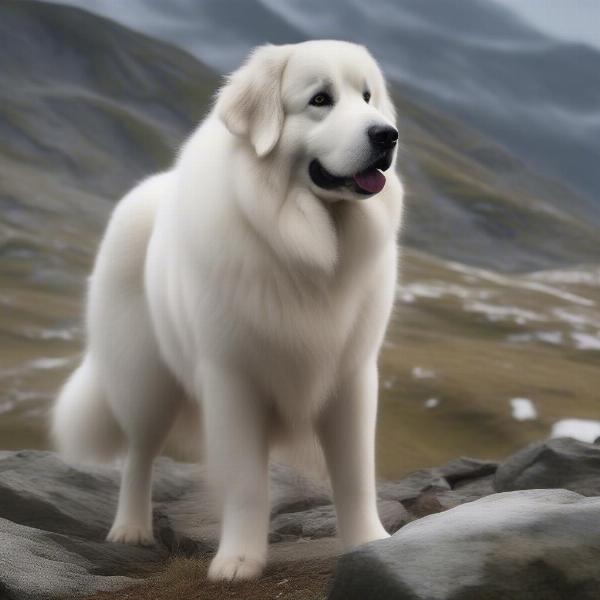Rear dewclaws, those extra little toes located higher up on a dog’s hind legs, are a fascinating and sometimes confusing topic for dog owners. While not all dogs have them, understanding their presence or absence can provide insights into breed history and potential health concerns. So, which dog breeds have rear dewclaws? Let’s delve into this intriguing topic.
Many dog owners are curious about the purpose of these extra digits. Historically, dewclaws likely served a purpose for canines in the wild, perhaps aiding in climbing or gripping prey. Today, their function is less clear, and they can sometimes even pose health risks, such as becoming snagged and torn. This article will discuss which breeds commonly have rear dewclaws, why some breeds retain them, and the potential health implications.
Understanding Rear Dewclaws: Why Are They There?
While front dewclaws are fairly common across dog breeds, rear dewclaws are less prevalent. They’re often considered a vestigial trait, meaning they’re a leftover from earlier stages of canine evolution. Some theories suggest that they were once used for added traction and stability, particularly in wild canines navigating uneven terrain.
The Role of Genetics in Rear Dewclaw Presence
The presence or absence of rear dewclaws is largely determined by genetics. Some breeds are genetically predisposed to having them, while others rarely or never do. This genetic predisposition can be traced back to the breed’s original purpose and ancestry. For instance, breeds that were historically used for climbing or working in mountainous terrain are more likely to have retained their rear dewclaws.
Dog Breeds Commonly Found with Rear Dewclaws
Several breeds are known for commonly having rear dewclaws, often even having double dewclaws. These include:
- Great Pyrenees: This large, majestic breed often boasts double rear dewclaws, believed to aid in navigating snowy mountainous regions.
- Briard: Another breed with a history of herding in mountainous regions, the Briard frequently has double rear dewclaws.
- Beauceron: This French herding breed also commonly exhibits double rear dewclaws.
- Icelandic Sheepdog: These hardy dogs, accustomed to challenging terrains, often have rear dewclaws.
 Great Pyrenees Dog With Dewclaws in Mountain Setting
Great Pyrenees Dog With Dewclaws in Mountain Setting
Other breeds that may sometimes have rear dewclaws include the Anatolian Shepherd, Estrela Mountain Dog, and Spanish Mastiff. It’s important to note that the presence of rear dewclaws can vary even within a breed, and not all individuals will have them. What dog breeds don’t have dewclaws? Find out more about dog breeds without dewclaws on our dedicated page: what dog breeds don’t have dewclaws.
Health Considerations for Rear Dewclaws
While rear dewclaws may seem like a minor detail, they can sometimes present health concerns. Because they are often loosely attached and don’t touch the ground regularly, they are prone to getting caught on objects, leading to tearing or injury. This can be painful for the dog and may require veterinary intervention.
Dewclaw Removal: A Common Practice?
Some breeders choose to remove rear dewclaws in puppies a few days after birth to prevent potential future injuries. This is a relatively simple procedure when performed early. However, it’s important to discuss the pros and cons of dewclaw removal with your veterinarian to make an informed decision for your dog. You can learn more about dog palm anatomy here: dog palm.
Conclusion
Rear dewclaws are a fascinating aspect of canine anatomy, reflecting the evolutionary history of different breeds. While they may no longer serve their original purpose in domesticated dogs, understanding their presence or absence can offer valuable insights into breed characteristics and potential health considerations. Whether your dog has rear dewclaws or not, regular paw care and veterinary check-ups are crucial for their overall health and well-being.
FAQ
- Do all dogs have rear dewclaws? No, rear dewclaws are less common than front dewclaws and are present only in certain breeds.
- Why do some breeds have double rear dewclaws? Double rear dewclaws are often seen in breeds historically used for working in mountainous or challenging terrains, potentially providing additional stability.
- Are rear dewclaws harmful? They can be if they get snagged and torn. Discuss the risks and benefits of removal with your vet.
- When are rear dewclaws usually removed? Removal, if chosen, is typically performed in puppies a few days after birth.
- Is dewclaw removal painful? It’s a relatively simple procedure when done early, but it’s important to discuss pain management with your vet.
- Can rear dewclaws grow back after removal? No, once surgically removed, they typically do not grow back.
- How can I care for my dog’s rear dewclaws? Regular inspection and trimming can help prevent injuries.
ILM Dog is a leading international website dedicated to providing expert advice on dog care and wellbeing. From breed selection to health and training, we offer comprehensive resources for dog owners worldwide. Whether you are a seasoned dog owner or just starting your journey, ILM Dog has the information you need. Contact us today via email at [email protected] or phone at +44 20-3965-8624. Visit ILM Dog for more expert advice on all aspects of dog care.